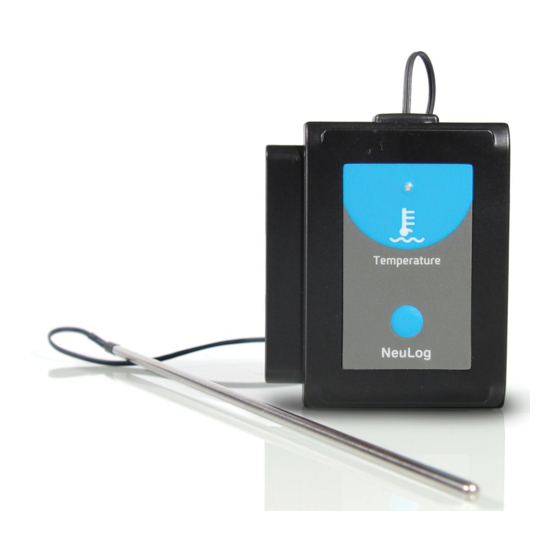
Advertisement
Quick Links
NeuLog CO
logger sensor
2
NUL-220
The CO
Sensor can be used for any science experiment where CO
2
required.
Some fields of study include Chemistry, Physiology, Exercise Science,
Biochemistry, Biology, Earth Science, Environmental Science, etc.
The sensor comes pre-calibrated so you can start experimentation right out of the box
using this guide.
This sensor is practical for testing CO
levels both in laboratories and in the field. An
2
electromechanical cell in the sensor reacts with carbon dioxide to produce a voltage
which is directly interpreted to give a CO
Among hundreds of possible experiments that can be performed with the NUL-202
sensor are: Monitoring ecological systems, combustion reactions, CO
rates, studying photosynthesis, testing chemical solutions, hydrogen peroxide
decomposition, and many more.
The NeuLog CO
sensor's measurement unit is:
2
Parts per million (ppm): The total number of carbon dioxide molecules per million
molecules sampled.
Sensor offset:
Prior to each use, the CO
sensor needs to warm up for roughly half an hour. For best
2
results, plug the CO
sensor into a USB or battery module and allow it to sit for half an
2
hour before to collecting data.
Open air mode:
Although the NeuLog CO
sensor does not need to be calibrated, it is recommended
2
to offset its probe.
The sensor offsets to the standard atmospheric CO
air (assuming stable levels in the Earth's atmosphere at sea level).
levels are
2
concentration reading.
2
consumption
2
concentration of 380 ppm in open
2
NEULOG CO2 LOGGER SENSOR GUIDE
Materials Needed:
NUL-220 CO
sensor
2
One of the following (depending on experiment type):
-
USB-200 Module (For On-line experiments)
-
BAT-200 Battery Module (For Off-line experiments)
-
VIEW-101 Graphic Display Module and BAT-200 Battery Module (Optional,
for use with NeuLog Viewer)
Procedure:
1.
It is recommended to offset the sensor outside (you can get it out through a
window if it is connected to a USB module).
2.
The CO
sensor needs a power supply to properly offset. Connect the CO
2
sensor to:
USB-200 module for On-line experiments
-
-
BAT-200 battery module for Off-line experiments
-
VIEW-101 graphic display module and BAT-200 battery module for use with
the NeuLog Viewer.
3.
After the sensor has been connected to a power supply for at least 30 minutes,
check that the values are relatively stable.
4.
The sensor now needs to be offset -
hold the probe vertically with the opening facing the ground.
Press and hold the blue "Start/Stop" button on the faceplate of the sensor for 3
5.
seconds.
6.
The CO
Sensor is now offset for use.
2
Quick start procedure:
PC or Mac Computer
Materials needed:
NUL-220 CO
Sensor
2
USB-200 USB Module
A USB to mini USB cable (included with the USB-200 module)
Prior to initial use the NeuLog CO
"Sensor offset" section in this document for detailed instructions.
sensor needs to be offset. Please review the
2
2
Advertisement

Summary of Contents for NeuLog NUL-220
- Page 1 A USB to mini USB cable (included with the USB-200 module) to offset its probe. Prior to initial use the NeuLog CO sensor needs to be offset. Please review the The sensor offsets to the standard atmospheric CO concentration of 380 ppm in open “Sensor offset”...
- Page 2 WIFI-201 module. The WIFI-201 module then connects to a computer via a USB to mini-USB cable. Please note that you will create a closed NeuLog Wi-Fi network which will stream the NeuLog data to a cannot plug the CO sensor directly into the computer.
- Page 3 (For more information on how to change the experiment settings, view the quick start procedure section for your chosen device in this document.) Operation with NeuLog Graphic Display Module (viewer) Connect the CO sensor directly to the left side of a charged BAT-200 module.
- Page 4 NeuLog body. This technology allows the sensor to collect and then By monitoring the electromotive force (EMF) generated between the two electrodes, it store the digital data in the correct scientific units ( F, Lux, %, ppm, for example).
- Page 5 NEULOG CO2 LOGGER SENSOR GUIDE Thank you for using NeuLog! Maintenance and storage: Never submerge the NeuLog sensor’s plastic body and probe in any liquid. Do not allow liquid into the NeuLog sensor’s plastic body and probe. ...












Need help?
Do you have a question about the NUL-220 and is the answer not in the manual?
Questions and answers